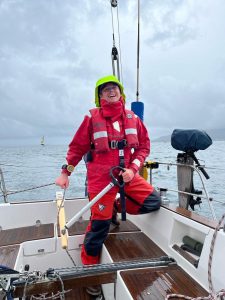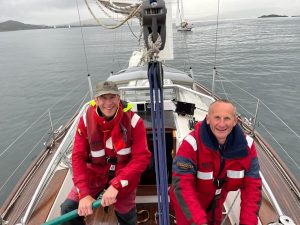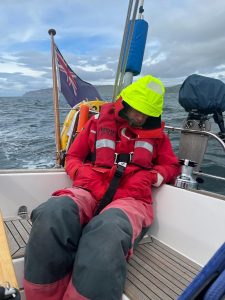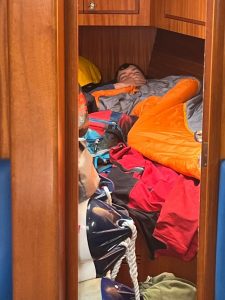Completing the Scottish Islands Peak Race – Nearly Within the Rules
On the 19 May, 2 Reservist ETS Officers; Lt Col Reid and 2Lt Coleman, set off to complete the Scottish Isles Peak Race, a niche event on the endurance athletes’ calendar. The two seasoned yachtsmen completed this supported by 3 Regular ETS Officers: Maj Boardman, Maj Common and Capt Morris. They did this with (greatly appreciated) support of the Ulysees trust.
The rules of the event are minimal and relatively easy to explain; teams are made up of 5 people; at least two people must run each of the land races; you cannot use the yacht’s engine whilst runners are onboard; runners must row ashore and back to the yacht for land races in another vessel. Explaining the breakdown of the event is altogether a different task: 2 runners complete the Oban dash (8Km on road and trail) before getting into their dinghy on the shoreline and meeting their yacht which is already under sail. From there, the team sail to Mull, where two runners row ashore again to complete a self-navigated marathon summitting Ben More (38Km), before rowing back to the yacht. From Mull to Jura, where two runners complete another arduous orienteering event over the Paps mountain range (20Km), before returning to the yacht (you get the picture now) via dinghy. On the final leg, the team sails around the Mull of Kintyre to The Isle of Arran, to complete the long ascent of Goat Fell from the shore (31Km), on return to the yacht and the team sail to Troon where the race finishes. In total, the team completes around 90km on-foot and 180 Nautical Miles.
The Educational and Training Services Team converged at Oban on the evening of Wednesday 18th and spent the first night aboard the yacht Petrel, kindly lent by the Joint Services Adventure Training Centre. Thursday was spent familiarising with the boat. At this point 2Lt Coleman our Skipper and Lt Col Reid realised they had their work cut out with three very unsteady pairs of hands to help them. “Take the buoy out of the Lazarette and put it portside ” 2Lt Coleman said to an audience of blank faces- he realised he was speaking the wrong language; “Take the orange round thing out of the cupboard, take to the left side and dangle it over so the boat doesn’t hit anything”. He had already demonstrated his ability to adapt and overcome in the face of adversity. Maj Boardman was quiet for the last couple of hours on the boat and his face had taken on a greenish hue. For anyone that has never met Maj Boardman, the team quickly learned that if he is silent, it is a sign that he is either asleep or feeling very ill. The team finished off the day by eating their weight in carbs in advance of what was to follow.
After briefings the Oban dash kicked the event off at 12:00 on Friday. Maj Common and Capt Morris had said they would treat it as a warm-up, but the speed of the pack was much quicker than anticipated and the route was much less flat than I had been promised. On re-boarding the yacht 2Lt Coleman and Lt Col Reid sailed our humble services yacht with finesse, overtaking some of the high-performance vessels that could achieve double Petrel’s speed. The ascent of Ben More was made more difficult by a head injury sustained by Maj Common, one of the runners, minutes before disembarking the boat. This was the result of some overzealous ‘clearing of the deck’ by the sailors who had been rowing due to a lack of wind. Maj Common was adamant to complete the course, so mk 1 bandage was applied round his head, and after a swift check by medical staff the runners set off on the 24-mile shore-to-summit ascent of the only Munroe on the course. They arrived back at the yacht after dark and sailed through the night to Jura.
Unfortunately, the team missed a tidal gate which stalled the passage but allowed a few hours respite for all. The skies cleared and a school of dolphins came to feed around the yacht. When the tide began to change, Petrel was back in action. Maj Common and Maj Boardman, two of the runners had been fairly unwell until this point and now Capt Morris was nil by mouth. In any case, the former runners completed the Paps route on Jura, which included several tough inclines over scree and rocks. On return to the boat, Petrel started making progress towards the dreaded Mull of Kintyre. By this point, the sailors were exhausted, and runners had to take the helm at various times to allow them to take much needed rest. Lt Col Reid began his own personal morale battle as a broken stove meant no more of the black tea he subsides on. The chinks in his armour began to appear and occasional pleading cries of ‘teaaa’ came from the helm throughout the night. To add insult to injury, we had also finished the chili that had fuelled us for the past few days- so not only was there no more hot food due to the gas shortage, but there wasn’t much to eat altogether.
At this point the team had to make a bigger decision about the viability of staying in the race. 2Lt Coleman had pushed our humble yacht, Petrel, within the safe limits set out by JSASTC and sailed exceptionally throughout supported only by Lt Col Reid. However, the team had missed another tidal gate, the wind had turned, and Petrel was looking to finish outside the agreed end-time, meaning changing transport plans to get home and missing work. Petrel officially withdrew from the race and put the engine on to get around the Mull. As soon as the wind and tide had turned back around, Lt Col Reid and 2Lt Coleman were sailing again. Capt Morris and Maj Boardman alighted for the final run on the Isle of Aran, up Goat Fell. Despite swollen feet and Maj Boardman’s unrelenting seasickness they made it around the 30 km course in good time.
Back onboard Petrel made the final journey to Oban with heads held high, knowing that they had achieved an incredible feat by completing the course, even if they had ‘cracked the engine’ on the penultimate leg. When they told the race organisers at the end that Petrel had withdrawn by turning the engine on they hardly blinked before handing the finishers’ certificates over. Evidently the spirit of the race was finishing in good order, rather than strict adherence to the rules. The team sat on the boat and had a couple of celebratory drinks. Despite the hardships that everyone had endured; Lt Col Reid going cold turkey from a lack of tea; Maj Boardman’s ruthless seasickness; Maj Common’s head injury; Capt Morris’s permanent leg cramps and 2Lt Coleman’s skippering with a largely land-loving crew; we the 5 agreed that they’d be back the following year, better prepared and with a greater knowledge of what the SIPR entails.
The Educational and Training Services Team certainly learned the value of preparation but also learned, or remembered the satisfaction one gets from being part of a small team in arduous conditions striving to achieve something extraordinary.





